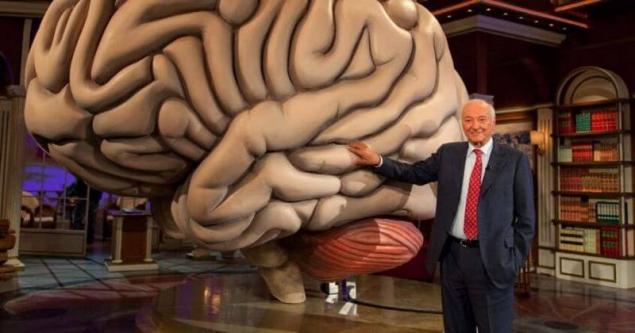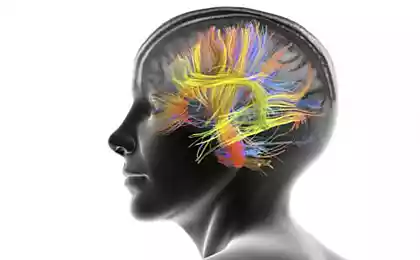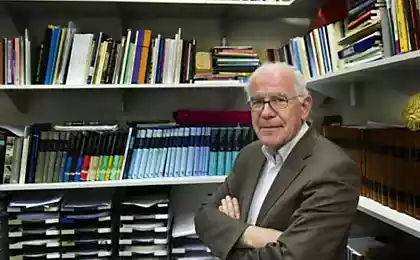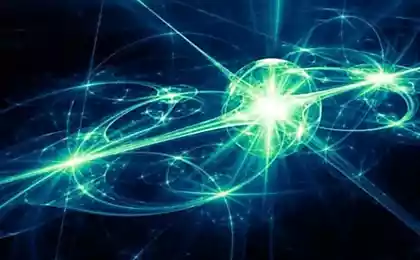472
6 the most important discoveries in the field of brain over the past year
Scientists found the difference between humans and animals Finally answered were always considered a rhetorical question: where is the human conscience? It is in lateral frontal cortex, i.e. just above the eyebrows.
Scientists at Oxford University found a person's conscience, most importantly, in their opinion, our difference from animals. On 29 January, reported by British media.
The area of the brain that does not allow us to make bad decisions, Oxford scientists have discovered by using brain scans on 25 men and women. Then they compared the brain scans of volunteers with pictures of the macaques, which are some of our closest relatives. Lateral frontal cortex consists of 12 departments. 11 of them are identical in humans and monkeys, but 12, the lateral frontal pole, the animals no.

Roughly speaking, conscience is a small bundle of nerve tissue in the ball shape and located in the lateral frontal cortex of the brain.
"We found a region of the brain, explained Professor Matthew Rushworth, which is exclusively human and not shared with any animals."
As expected, the conscience of people of different sizes. Some quite small, about the size of cabbage Brussels sprouts; others have more of a tangerine.
This part of the brain is particularly important in multi-tasking activities. For example, if a person decides to do something, it will reflect on other options and present them to the consequences. From an article in the journal Neuron, where the Oxford scientists published the results of their study, it follows thatthis part of the brain also allows us to learn from the mistakes of others, it accelerates the acquisition of new skills and has many other useful functions. One of them is the choice between good and evil.
Last year, scientists examined the brains of humans and animals. We chose the six most important, in our opinion, discoveries in this field.
1. The brain of men and women are wired differently Carefully studied the brain scans of 428 521 representatives of the stronger and the fairer half of humanity in age from 8 to 22, scientists at the University of Pennsylvania came to the conclusion that women's brains differ from men's. Women have stronger connection between the left and right hemispheres of the brain at the time, as men – between the front and rear parts.

This insignificant, at first glance, the difference explains the difference in thought processes between the sexes. Because the left hemisphere of the brain more associated with logical thinking while the right side is intuitive, men are better able to perform tasks associated with perception and coordinated action, and women with social activities and all that is connected with memory. This, incidentally, makes them better adapted to a multitasking operation mode.
2. Extra pounds and fascination pornography on the Internet affect memory Scientists from the Swedish University of Umea found that fat people suffer from memory loss. They in half a year watched 20 women older than 60 years who were put on a diet. Together with fat loss and improved memory, active working areas of the brain responsible for the identification and comparison of individuals, increased efficiency of the process of information extraction.
At the University of Duisburg-Essen think that the easiest way to turn into scattered and forgetful person, overseeding pornography online.
All 28 of the participants were heterosexual and had a median age of 26. They many times showed on the screen of a computer the photographs as pornographic, and not having sex is irrelevant. Moreover, many repeated. Participants pressed the "Yes" button when they showed those that they have seen among their last four shots, and "no" when they saw something new.
It turned out that most mistakes volunteers made during the viewing of pornographic images. Moreover, the difference compared with non-sexual images were quite significant. On average, they responded correctly in 67% of cases, when seen pornography, and 80% when images of non-sexual content.
3. The blue light helps to keep the vigor and concentration of Swedish researchers from the University of the Ministry of foreign Affairs is Reduced compared the effect of blue light and caffeine on the human brain. It turned out thatblue light has enough power to turn the human body are certain biological functions. Positive effect it is superior to caffeine.
The blue light better than coffee allows you to keep vigor. In addition, it helps to keep concentration at a high level and improves cognitive abilities such as memory and reaction.
4. The brain responds differently to foodthe Way to a man's heart, however, as well as women, is not through the stomach, and over her head, confident in the Institute of clinical psychology in Pisa most clearly this dependence is manifested in the love of some people with a sweet tooth. Some even typical photograph of chocolate brings wild, while others are completely indifferent to sweets. And the first and second the same as all other people, likes and dislikes in food meets the brain.
Italian scientists have shown thatthe brains of people reacts differently to food. They fed the participants a chocolate cake and showed them the sweets on the screen and watched the activity of their brain. Some reaction was muted. The front part of their brain was like in a state of hibernation. Have a sweet tooth, she showed increased activity.
Junk food is as addictive as heroin or cigarettes. Experiments show that burgers, chips and other food from fast food restaurants makes our brain to demand more sugar and salt.
5. The ability to remember what was not, has an explanation Susumu, Tonegawa from mit with assistants implanted mouse false memory. It was done with the manipulation of individual neurons, i.e. optogenetics, technique that allows to control brain cells. Tonegawa of changed cells in the rodent hippocampus, which are responsible for the production of the protein rhodopsin. When cells with rhodopsin is irradiated with blue light, as if they Wake up and begin to work vigorously.
The mouse was placed in chamber and allowed to study it thoroughly.. The corresponding cells produced rhodopsin, that is, was the process of remembering. On the second day, the same mouse has moved to another cell. There she was given a weak electric shock for she remembered the fear. At the same time included a blue light to turn memories of the first chamber. Thus, in the memory of a rodent fright was beginning to associate with the first camera.
Then the mouse returned to the first chamber. She froze on the doorstep and showed all the classic signs of fear, although no negative memories associated with her, she was not.
6. The brain works at an astronomical rate , researchers from the Massachusetts Institute of technology (MIT) proved the fallacy of the popular phrase: "something I'm slow on the uptake". Our brain works almost 8 times faster than previously thought. In order to "fix" the visual image, not 100 milliseconds as previously thought, but only 13.
Participants in the experiment were asked to find a series of 6-12 show them for 13-80 milliseconds images pictures picnic and smiling couples. With the task they have coped quite well.
Previously it was thought that a person needs at least 100 milliseconds in order to distinguish between visual images.
P. S. And remember, only by changing their consumption — together we change the world! ©
Join us in Facebook , Vkontakte, Odnoklassniki
Source: expert.ru/2014/01/29/shest-samyih-vazhnyih-otkryitij-v-oblasti-golovnogo-mozga-za-poslednij-god/?553311
Scientists at Oxford University found a person's conscience, most importantly, in their opinion, our difference from animals. On 29 January, reported by British media.
The area of the brain that does not allow us to make bad decisions, Oxford scientists have discovered by using brain scans on 25 men and women. Then they compared the brain scans of volunteers with pictures of the macaques, which are some of our closest relatives. Lateral frontal cortex consists of 12 departments. 11 of them are identical in humans and monkeys, but 12, the lateral frontal pole, the animals no.

Roughly speaking, conscience is a small bundle of nerve tissue in the ball shape and located in the lateral frontal cortex of the brain.
"We found a region of the brain, explained Professor Matthew Rushworth, which is exclusively human and not shared with any animals."
As expected, the conscience of people of different sizes. Some quite small, about the size of cabbage Brussels sprouts; others have more of a tangerine.
This part of the brain is particularly important in multi-tasking activities. For example, if a person decides to do something, it will reflect on other options and present them to the consequences. From an article in the journal Neuron, where the Oxford scientists published the results of their study, it follows thatthis part of the brain also allows us to learn from the mistakes of others, it accelerates the acquisition of new skills and has many other useful functions. One of them is the choice between good and evil.
Last year, scientists examined the brains of humans and animals. We chose the six most important, in our opinion, discoveries in this field.
1. The brain of men and women are wired differently Carefully studied the brain scans of 428 521 representatives of the stronger and the fairer half of humanity in age from 8 to 22, scientists at the University of Pennsylvania came to the conclusion that women's brains differ from men's. Women have stronger connection between the left and right hemispheres of the brain at the time, as men – between the front and rear parts.

This insignificant, at first glance, the difference explains the difference in thought processes between the sexes. Because the left hemisphere of the brain more associated with logical thinking while the right side is intuitive, men are better able to perform tasks associated with perception and coordinated action, and women with social activities and all that is connected with memory. This, incidentally, makes them better adapted to a multitasking operation mode.
2. Extra pounds and fascination pornography on the Internet affect memory Scientists from the Swedish University of Umea found that fat people suffer from memory loss. They in half a year watched 20 women older than 60 years who were put on a diet. Together with fat loss and improved memory, active working areas of the brain responsible for the identification and comparison of individuals, increased efficiency of the process of information extraction.
At the University of Duisburg-Essen think that the easiest way to turn into scattered and forgetful person, overseeding pornography online.
All 28 of the participants were heterosexual and had a median age of 26. They many times showed on the screen of a computer the photographs as pornographic, and not having sex is irrelevant. Moreover, many repeated. Participants pressed the "Yes" button when they showed those that they have seen among their last four shots, and "no" when they saw something new.
It turned out that most mistakes volunteers made during the viewing of pornographic images. Moreover, the difference compared with non-sexual images were quite significant. On average, they responded correctly in 67% of cases, when seen pornography, and 80% when images of non-sexual content.
3. The blue light helps to keep the vigor and concentration of Swedish researchers from the University of the Ministry of foreign Affairs is Reduced compared the effect of blue light and caffeine on the human brain. It turned out thatblue light has enough power to turn the human body are certain biological functions. Positive effect it is superior to caffeine.
The blue light better than coffee allows you to keep vigor. In addition, it helps to keep concentration at a high level and improves cognitive abilities such as memory and reaction.
4. The brain responds differently to foodthe Way to a man's heart, however, as well as women, is not through the stomach, and over her head, confident in the Institute of clinical psychology in Pisa most clearly this dependence is manifested in the love of some people with a sweet tooth. Some even typical photograph of chocolate brings wild, while others are completely indifferent to sweets. And the first and second the same as all other people, likes and dislikes in food meets the brain.
Italian scientists have shown thatthe brains of people reacts differently to food. They fed the participants a chocolate cake and showed them the sweets on the screen and watched the activity of their brain. Some reaction was muted. The front part of their brain was like in a state of hibernation. Have a sweet tooth, she showed increased activity.
Junk food is as addictive as heroin or cigarettes. Experiments show that burgers, chips and other food from fast food restaurants makes our brain to demand more sugar and salt.
5. The ability to remember what was not, has an explanation Susumu, Tonegawa from mit with assistants implanted mouse false memory. It was done with the manipulation of individual neurons, i.e. optogenetics, technique that allows to control brain cells. Tonegawa of changed cells in the rodent hippocampus, which are responsible for the production of the protein rhodopsin. When cells with rhodopsin is irradiated with blue light, as if they Wake up and begin to work vigorously.
The mouse was placed in chamber and allowed to study it thoroughly.. The corresponding cells produced rhodopsin, that is, was the process of remembering. On the second day, the same mouse has moved to another cell. There she was given a weak electric shock for she remembered the fear. At the same time included a blue light to turn memories of the first chamber. Thus, in the memory of a rodent fright was beginning to associate with the first camera.
Then the mouse returned to the first chamber. She froze on the doorstep and showed all the classic signs of fear, although no negative memories associated with her, she was not.
6. The brain works at an astronomical rate , researchers from the Massachusetts Institute of technology (MIT) proved the fallacy of the popular phrase: "something I'm slow on the uptake". Our brain works almost 8 times faster than previously thought. In order to "fix" the visual image, not 100 milliseconds as previously thought, but only 13.
Participants in the experiment were asked to find a series of 6-12 show them for 13-80 milliseconds images pictures picnic and smiling couples. With the task they have coped quite well.
Previously it was thought that a person needs at least 100 milliseconds in order to distinguish between visual images.
P. S. And remember, only by changing their consumption — together we change the world! ©
Join us in Facebook , Vkontakte, Odnoklassniki
Source: expert.ru/2014/01/29/shest-samyih-vazhnyih-otkryitij-v-oblasti-golovnogo-mozga-za-poslednij-god/?553311























